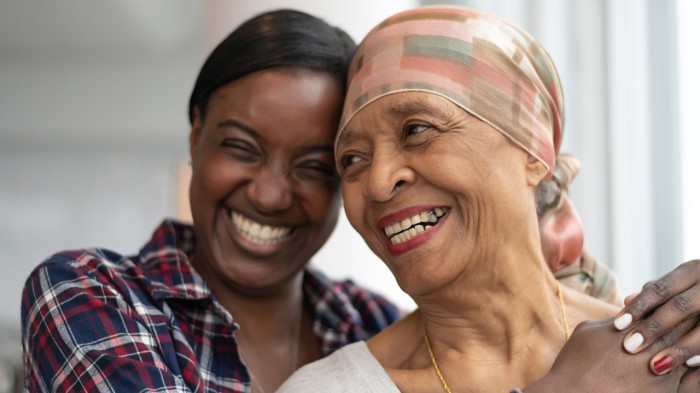In OTC Category Reviews
Follow month by month updates on topics including asthma, mental health and skin conditions and be able to provide informed advice to customers at the counter.Bookmark
Over 22,000 women are diagnosed with a gynaecological cancer each year in the UK. These cancers affect the womb, ovaries, cervix, vulva or vagina, according to the latest data released by The Eve Appeal
“This is 60 new diagnoses of a gynaecological cancer each day,” says Helen Hyndman, Ask Eve co-ordinator at the charity. “Despite these statistics, these cancers are often not talked about due to stigma and embarrassment. A recent survey run by The Eve Appeal (YouGov) showed that 30 per cent of people are not aware of any types of gynaecological cancer, and only two per cent of people think they can name all five types of gynaecological cancer.”
According to the Royal College of Nursing, it’s important that all healthcare professionals are aware of the common signs and symptoms associated with gynaecological cancers and respond appropriately to the red flags. Pharmacy customers should be encouraged to speak to their GP if they experience any unusual or ongoing symptoms, such as pain, bleeding or vaginal discharge.
“Community pharmacies should use health promotions throughout the year to raise awareness about the importance of gynaecological screenings,” says Jacquie Lee, Numark information pharmacist. “Through keeping an eye on events in the calendar such as Gynaecological Cancer Awareness Month (September) and Cervical Screening Awareness Week (June), pharmacy teams can shed light on gynaecological screenings and demystify what they entail. Community pharmacies should also provide promotional materials, which can help educate customers about what to expect from a gynaecological screening.”
The Eve Appeal raises awareness about all five cancers. Information, support and advice is also available from Cancer Research UK, Macmillan Cancer Support and other gynaecological cancer charity websites.
Womb (endometrial) cancer
Most people who get womb cancer tend to be aged between 40 and 74. Being overweight or obese causes around a third of womb cancers and is the biggest preventable risk factor. Women with more fat cells in their body tend to have higher levels of oestrogen, which triggers womb cells to divide and grow. The more oestrogen they have, the thicker their womb lining becomes and the more likely one of the cells will become cancerous. Anything else that increases the amount of oestrogen in the body can also increase the risk of womb cancer. Other risk factors include:
- Oestrogen-only hormonal replacement therapy (HRT)
- Family history
- Tamoxifen, taken for some types of breast cancer
- Diabetes (which may be linked to being overweight)
- Polycystic ovary syndrome
- Starting periods at a young age
- Late menopause.
The risk may be decreased by:
- Having children
- Taking the contraceptive pill
- Physical activity.
The most common symptoms are bleeding between periods, after the menopause or after sex; unusually heavy periods; and coloured or watery vaginal discharge that may have an unpleasant odour.
Less common signs include blood in the urine, high platelet count and high blood sugar level. If women have gone through the menopause (they are 12 months after their last period) and experience post-menopausal bleeding, they should speak to their GP.
Womb cancer is usually diagnosed with an ultrasound scan, followed by a biopsy. There’s no national screening programme, but if women are considered to be high risk due to their family history (called Lynch syndrome or HNPCC families) they may be offered a screening biopsy from the age of 35-40.
Ovarian cancer
The risk of developing ovarian cancer increases as people get older, with the highest risk in those aged 75-79. Between five to 15 out of 100 ovarian cancers are caused by faulty genes, such as BRCA1 and BRCA2.
Other risk factors include previous breast cancer, HRT, smoking, endometriosis, diabetes, being overweight or obese.
Protective factors include:
- Combined contraceptive pill
- Having children
- Breastfeeding
- Having a hysterectomy or tubes tied.
The symptoms of ovarian cancer may include:
- Persistent bloating
- Persistent pelvic/abdominal pain
- Feeling full quickly
- Constipation or diarrhoea
- Loss of appetite
- Change in bowel habits
- Needing to urinate more regularly
- Abnormal vaginal bleeding
- Unexplained weight loss and/or fatigue.
These symptoms can occur in other conditions, such as irritable bowel syndrome (IBS), but new, severe or ongoing symptoms, especially after the age of 50, should be checked out by a GP.
Most ovarian cancers can be diagnosed with a blood test (raised serum CA125). This is usually followed up with an ultrasound if symptoms are present, whether or not CA125 levels are raised. Definitive diagnosis requires a biopsy. There’s no reliable screening test for ovarian cancer.
Cervical cancer
The main cause of cervical cancer is a long-lasting infection with certain types of the human papilloma virus (HPV). HPV can be passed on through unprotected sex. In most people, the immune system clears HPV within a couple of years, but sometimes the virus persists.
Girls and boys aged 12 or 13, born after 1 September 2006, in the UK are routinely offered the HPV vaccine at school to protect against most types of the condition and reduce the risk of cervical and other cancers.
Other risk factors include:
- HIV infection
- Sexually transmitted infections (STIs)
- Smoking tobacco
- Taking the contraceptive pill for more than five years
- Having children
- Family history.
Not everyone with cervical cancer has symptoms. The most common symptoms, when they do occur, are bleeding between periods or after sex, pain or discomfort during sex, unpleasant-smelling vaginal discharge and pelvic pain.
Screening is free on the NHS as part of the National Cervical Screening Programme. It checks for high-risk HPV and abnormal cervical cell changes. A nurse takes a sample of cells from the cervix using a small soft brush (smear test) and sends the sample to the laboratory.
Everyone with a cervix should be automatically invited for cervical screening if they are the ages between 25-65 and are registered as a female with a GP surgery (see box out on page 26). England, Scotland and Wales use HPV primary screening, which tests for HPV first. If high-risk HPV is found, the laboratory will check for cell changes. Currently, in Northern Ireland, the laboratory looks for changes in the cervical cells first and then tests for HPV should they find any changes. This is, however, expected to switch to HPV primary screening soon.
In England and Northern Ireland, eligible people receive an invitation to book a screening every three years if they are aged 25-49. After that, they will receive an invite every five years until the age of 64. In Wales and Scotland, an invite is sent every five years to those eligible aged 25-64.
Doctors use a colposcopy with biopsy after abnormal cervical screening tests or if someone has symptoms that could be caused by cervical cancer. Some women may have a cone biopsy as a treatment for abnormal cervical cells or to help diagnose cervical cancer.
Vulval cancer
Vulval cancer can affect all age groups but is more common in women aged 75 and older. HPV causes some vulval cancers, but is not the only potential cause. For example, other risk factors include some long term vulval skin conditions (lichen sclerosus and lichen planus), pre-cancerous cervical changes, previous cervical cancer, weakened immune system and systemic lupus erythematosus (SLE or lupus).
Symptoms
Early symptoms tend to be quite vague, but may include:
- Vulval itching that doesn’t go away
- Pain or soreness
- Thickened, raised, red, white or dark patches of the skin of the vulva
- A lump or open sore on the vulva.
Other symptoms may include:
- Burning pain when passing urine
- Discharge or bleeding, not related to periods
- A lump or swelling in the groin
- A mole on the vulva that changes shape or colour.
Some doctors recommend self-examination to be alert for any changes. The diagnosis includes a vaginal examination and pelvic examination, along with a biopsy.
Vaginal cancer
Vaginal cancer is more common in women aged 75 and over and is very rare in the under 40s. Risk factors include HPV infection, abnormal changes to vaginal cells and a weakened immune system.
There are no symptoms in the early stages, and up to 20 per cent of women diagnosed with vaginal cancer don’t have any symptoms at all. Doctors may pick up signs during routine cervical screening.
Symptoms may include:
- Bleeding between periods or after the menopause
- Bleeding after sex
- Bad-smelling or blood-stained discharge
- Pain during sex
- A vaginal lump
- Persistent vaginal itch.
The first tests are a pelvic examination and a colposcopy to see around the vulva and inside the vagina. This is usually followed by a biopsy.
Sponsored
 Sponsored education
Sponsored education
A different approach to pain
Complete this interactive video to rethink your pain recommendations and ensure you offer every customer the most appropriate advice
 Sponsored education
Sponsored education
Managing fever in children
Get to grips with the current guidance on managing fever in children and how antipyretics can help, and discover products you can recommend.


Record my learning outcomes